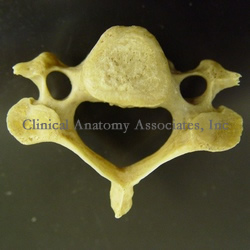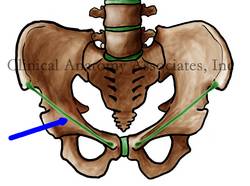
Medical Terminology Daily (MTD) is a blog sponsored by Clinical Anatomy Associates, Inc. as a service to the medical community. We post anatomical, medical or surgical terms, their meaning and usage, as well as biographical notes on anatomists, surgeons, and researchers through the ages. Be warned that some of the images used depict human anatomical specimens.
You are welcome to submit questions and suggestions using our "Contact Us" form. The information on this blog follows the terms on our "Privacy and Security Statement" and cannot be construed as medical guidance or instructions for treatment.
We have 382 guests online

Georg Eduard Von Rindfleisch
(1836 – 1908)
German pathologist and histologist of Bavarian nobility ancestry. Rindfleisch studied medicine in Würzburg, Berlin, and Heidelberg, earning his MD in 1859 with the thesis “De Vasorum Genesi” (on the generation of vessels) under the tutelage of Rudolf Virchow (1821 - 1902). He then continued as a assistant to Virchow in a newly founded institute in Berlin. He then moved to Breslau in 1861 as an assistant to Rudolf Heidenhain (1834–1897), becoming a professor of pathological anatomy. In 1865 he became full professor in Bonn and in 1874 in Würzburg, where a new pathological institute was built according to his design (completed in 1878), where he worked until his retirement in 1906.
He was the first to describe the inflammatory background of multiple sclerosis in 1863, when he noted that demyelinated lesions have in their center small vessels that are surrounded by a leukocyte inflammatory infiltrate.
After extensive investigations, he suspected an infectious origin of tuberculosis - even before Robert Koch's detection of the tuberculosis bacillus in 1892. Rindfleisch 's special achievement is the description of the morphologically conspicuous macrophages in typhoid inflammation. His distinction between myocardial infarction and myocarditis in 1890 is also of lasting importance.
Associated eponyms
"Rindfleisch's folds": Usually a single semilunar fold of the serous surface of the pericardium around the origin of the aorta. Also known as the plica semilunaris aortæ.
"Rindfleisch's cells": Historical (and obsolete) name for eosinophilic leukocytes.
Personal note: G. Rindfleisch’s book “Traité D' Histologie Pathologique” 2nd edition (1873) is now part of my library. This book was translated from German to French by Dr. Frédéric Gross (1844-1927) , Associate Professor of the Medicine Faculty in Nancy, France. The book is dedicated to Dr. Theodore Billroth (1829-1894), an important surgeon whose pioneering work on subtotal gastrectomies paved the way for today’s robotic bariatric surgery. Dr. Miranda.
Sources:
1. "Stedmans Medical Eponyms" Forbis, P.; Bartolucci, SL; 1998 Williams and Wilkins
2. "Rindfleisch, Georg Eduard von (bayerischer Adel?)" Deutsche Biographie
3. "The pathology of multiple sclerosis and its evolution" Lassmann H. (1999) Philos Trans R Soc Lond B Biol Sci. 354 (1390): 1635–40.
4. “Traité D' Histologie Pathologique” G.E.
Rindfleisch 2nd Ed (1873) Ballieres et Fils. Paris, Translated by F Gross
"Clinical Anatomy Associates, Inc., and the contributors of "Medical Terminology Daily" wish to thank all individuals who donate their bodies and tissues for the advancement of education and research”.
Click here for more information
- Details
This complex medical word is formed by the combination of two root terms: [dacry-] meaning "tear" and [-cyst-], meaning "sac". The combined root [dacryocyst-] means "tear sac" or better, "lacrimal sac" (the Latin word [lacrima] means "tear"). This medical word also has a combined suffix: [-(o)lith], meaning "stone", and [-iasis], meaning "disease or condition".
The word [dacryocystolithiasis] means then, "a condition or pathology of stones (calculi) in the lacrimal sac". The procedure to remove the stones would then be called a [dacryocystolithectomy].
- Details
The Hamate bone is one of the four bones that comprise the distal row of the carpus or carpal bones that form the wrist. The name arises from the Latin [hamatus], meaning "hooked". The hamate bone has a distinct hook-like bony process in its volar (anterior) surface, known as the hamulus. This bone is also known as the "unciform bone" (from the Latin [uncus], also meaning "hook") or the os hamatum.
The lunate bone has a wedge-like shape and six surfaces (as a die). It articulates with five bones, including the lunate bone, capitate, triquetrum, and the fourth and fifth metacarpal bones.
The hook of the hamate bone is one of the distal boundaries of the carpal tunnel and serves as a pulley for the tendons of the fourth and fifth flexor tendons. It also serves as one of the points of muscular attachment for the following muscles: flexor carpi ulnaris, flexor digit minimi, and opponens digiti minimi. Because of its projection into the palm of the hand, the hamulus is involved in injuries in sports that require the athlete to use an accessory, as in racquetball, tennis, baseball, golf, etc.
The accompanying image shows the anterior (volar) surface of the wrist.
Image modified from the original: 3D Human Anatomy: Regional Edition DVD-ROM Courtesy of Primal Pictures
- Details

The word itself arises from the Greek. The root term [-phleb-] derives from [φλέβα] (phleba) meaning "vein", and the suffix [-otomy], meaning "to cut" or "to open". Let's not forget that the suffix component [-y] means "process of". So [phlebotomy] is the "process (or action) of cutting open a vein"
For centuries a standard practice in medicine was to "bleed" a patient, by opening a vein under controlled conditions and letting some blood flow. The practice was known as "bloodletting" or phlebotomy. Not in use today, it is said that excessive bloodletting contributed to the death of George Washington, having removed 5 pints of blood in one day!. Today the professionals who draw blood are called "phlebotomists"
The image (circa 1860) depicts one of the only known three photographs of a bloodletting procedure. Observe the lack of aseptic technique.
Image in the public domain, by The Burns Archive, courtesy of Wikipedia.org.
- Details
The iliopubic tract is a thickening of the transversalis fascia found in direct relation, immediately posterior to the inguinal (Poupart's) ligament. As the inguinal ligament, the iliopubic tract extends between the anterior superior iliac spine (ASIS) superolaterally, and the pubic tubercle inferomedially.
This obscure structure has been brought up to light because it is one of the anatomical landmarks used in laparoscopic herniorrhaphy. When securing a mesh to reinforce the posterior abdominal wall, and also prevent mesh migration, the surgeon will place sutures, tacks, or staples in this structure. Since the iliopubic tract (posteriorly) and the inguinal ligament (anteriorly) are so close together, they are both secured when doing this procedure.
The image shows the location of the inguinal ligament. The iliopubic tract is immediately posterior to it.
Image property of: CAA, Inc. Artist: David M. Klein
- Details

Left clavicle, superior surface
The clavicle is part of the anterior portion of the shoulder girdle. It is an elongated bone with an "italic S" curvature. The Latin term for clavicle is [clavicula], and it has two root terms: [-clavic-] and [-clav-]. This is why we have the terms [subclavicular], and [subclavian] both meaning the same: "inferior to the clavicle".
The clavicle articulates medially with the manubrium of the sternum (see image on this article) by way of the sternoclavicular joint. This joint contains a meniscus. Laterally, the clavicle articulates with the acromial process or acromium of the scapula.
The clavicle has the muscular insertions of several muscles: sternocleidomastoid, trapezius, pectoralis major, deltoid, subclavius, and sternohyoid.
Sources:
1. "The Origin of Medical Terms" Skinner, HA 1970 Hafner Publishing Co.
2 "Tratado de Anatomia Humana" Testut et Latarjet 8 Ed. 1931 Salvat Editores, Spain
3. "Anatomy of the Human Body" Henry Gray 1918. Philadelphia: Lea & Febiger
Image modified by CAA, Inc. Original image by Henry Vandyke Carter, MD., courtesy of bartleby.com
- Details

Cervical vertebra, superior view
The term [foramen transversarium] is Latin for "transverse foramen". It refers to bilateral foramina (openings) found lateral to the vertebral body in the cervical vertebrae. These foramina are found only in cervical vertebrae and serve as a good way to identify them.
Through the foramina transversaria (plural form) pass the vertebral artery and vertebral vein. The vertebral artery is one of the first branches to arise off the subclavian arteries. While the vertebral vein passes through all seven foramina transversaria, the vertebral artery does not pass through the foramen transversarium of the seventh cervical vertebra (vertebra prominens).
Image property of:CAA.Inc.Photographer:David M. Klein



